The giraffe, with its towering neck and distinctive spotted coat, stands as one of nature’s most remarkable architectural achievements. Yet among its many extraordinary features, perhaps none is more fascinating than its tongue – a marvel of biological engineering that can reach nearly seven feet in length. This extraordinary appendage is not merely a curiosity but a sophisticated adaptation that has evolved to serve multiple critical functions in the giraffe’s daily life. From its unusual coloration to its remarkable dexterity, the giraffe’s tongue represents one of the animal kingdom’s most specialized feeding tools, enabling these gentle giants to thrive in environments where other herbivores might struggle. As we explore the truth about this remarkable organ, we’ll discover how this seemingly simple body part reveals complex evolutionary processes and ingenious natural design.
The Remarkable Length of a Giraffe’s Tongue
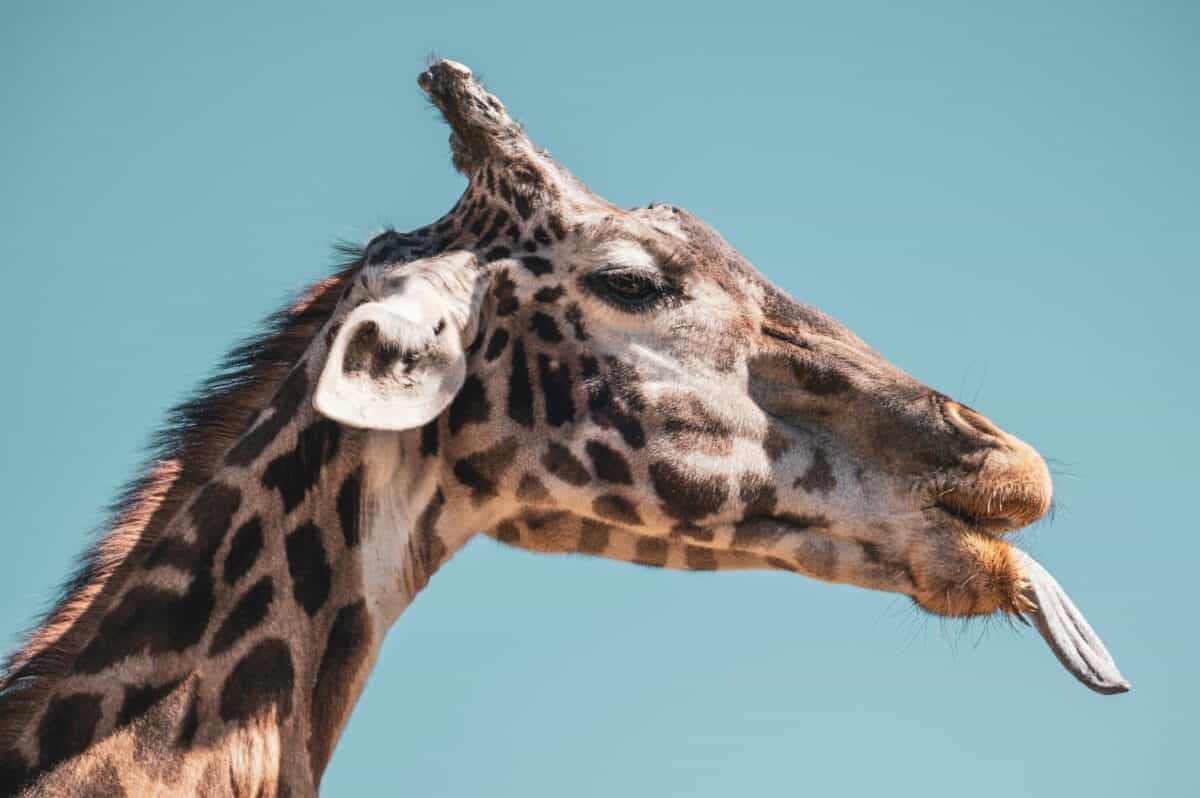
The giraffe’s tongue truly stands as one of nature’s most impressive anatomical achievements, measuring up to 21 inches (53 centimeters) in length. While popular accounts sometimes exaggerate this length to seven feet, the actual measurement is still extraordinary when compared to tongues of similar-sized mammals. This exceptional length evolved specifically to complement the giraffe’s long neck, creating a feeding apparatus perfectly designed for the animal’s unique ecological niche.
What makes this adaptation even more remarkable is the tongue’s incredible dexterity. Giraffes possess extraordinary muscular control over this extended appendage, allowing them to perform precise movements necessary for selective feeding. They can extend their tongues far beyond their mouths to reach foliage that would otherwise be inaccessible, and can wrap, curl, and manipulate their tongues around branches and leaves with astonishing precision. This combination of length and control gives giraffes a significant advantage in their savanna habitats, where competition for food resources can be intense.
The Distinctive Blue-Black Coloration
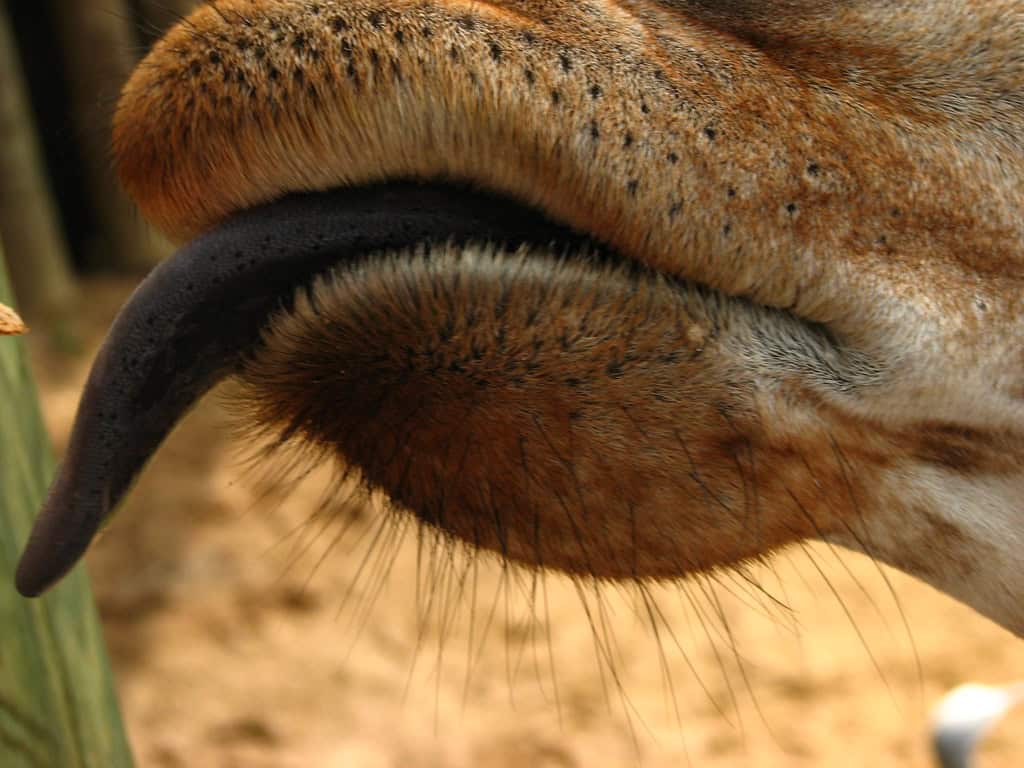
Perhaps one of the most visually striking features of a giraffe’s tongue is its distinctive dark blue-purple to black coloration – a characteristic that often surprises first-time observers. This unusual pigmentation isn’t merely a biological curiosity but serves a critical protective function. The dark coloration contains extra melanin, which helps shield the tongue from sunburn and sun damage during the many hours giraffes spend feeding in the open African savanna, where UV radiation levels are particularly intense.
Considering that giraffes may spend up to 12 hours per day feeding with their tongues extended to the sun, this adaptation proves essential for preventing painful damage that could compromise their ability to feed efficiently. The melanin acts as a natural sunscreen, absorbing harmful UV rays before they can damage the sensitive tissues of the tongue. This evolutionary adaptation demonstrates how even seemingly minor characteristics like coloration can play vital roles in an animal’s survival strategy, perfectly tailoring the giraffe to its specific environmental challenges.
Specialized Feeding Adaptations
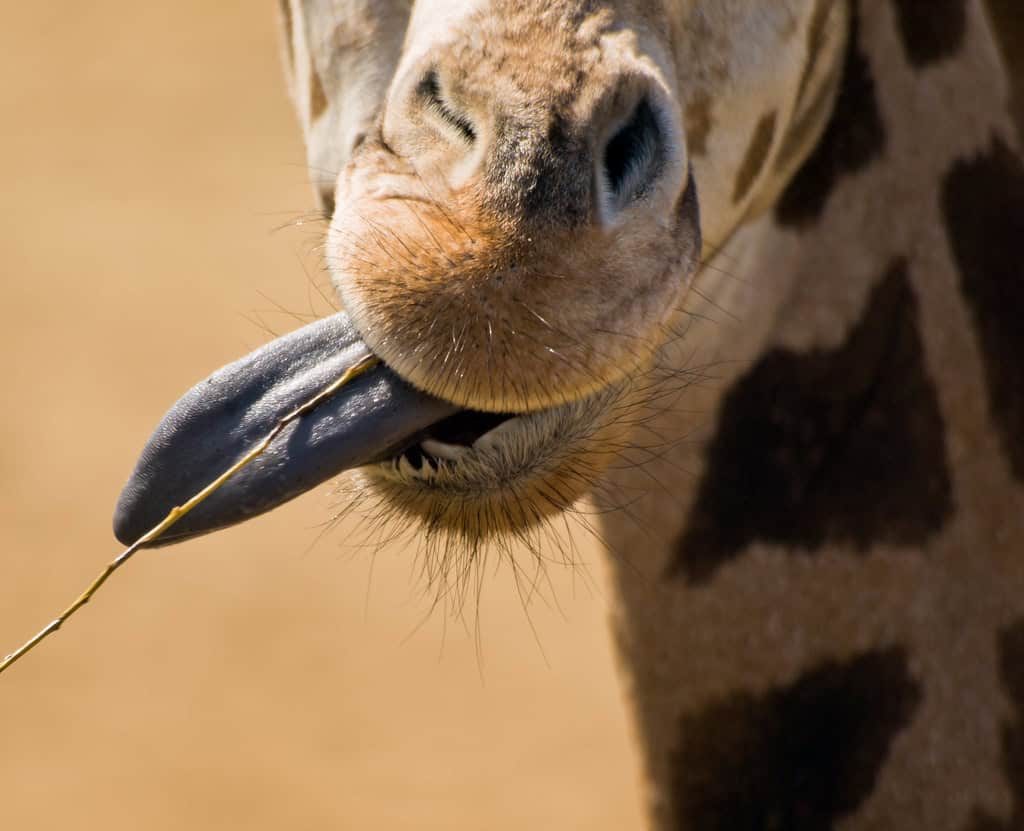
The giraffe’s tongue represents the centerpiece of a highly specialized feeding system that has evolved specifically for browsing on thorny acacia trees, which make up a significant portion of their diet. The tongue’s prehensile nature allows it to navigate between sharp thorns with remarkable precision, grasping leaves while avoiding painful injuries. This specialized manipulation enables giraffes to access foliage that would be dangerous or impossible for other herbivores to reach, effectively reducing competition for this food source.
Complementing this dexterity is a series of specialized adaptations that work in concert with the tongue. The tongue’s surface is covered with thick, tough papillae and coated with sticky saliva that helps adhere to leaves and pull them into the mouth. Additionally, giraffes have developed thick, pliable lips and a hardened palate that work together with the tongue to efficiently strip leaves from branches. These coordinated adaptations allow giraffes to consume up to 75 pounds (34 kilograms) of foliage daily, demonstrating how this extraordinary tongue forms part of a comprehensive feeding strategy perfectly tailored to their ecological role.
Muscular Structure and Control
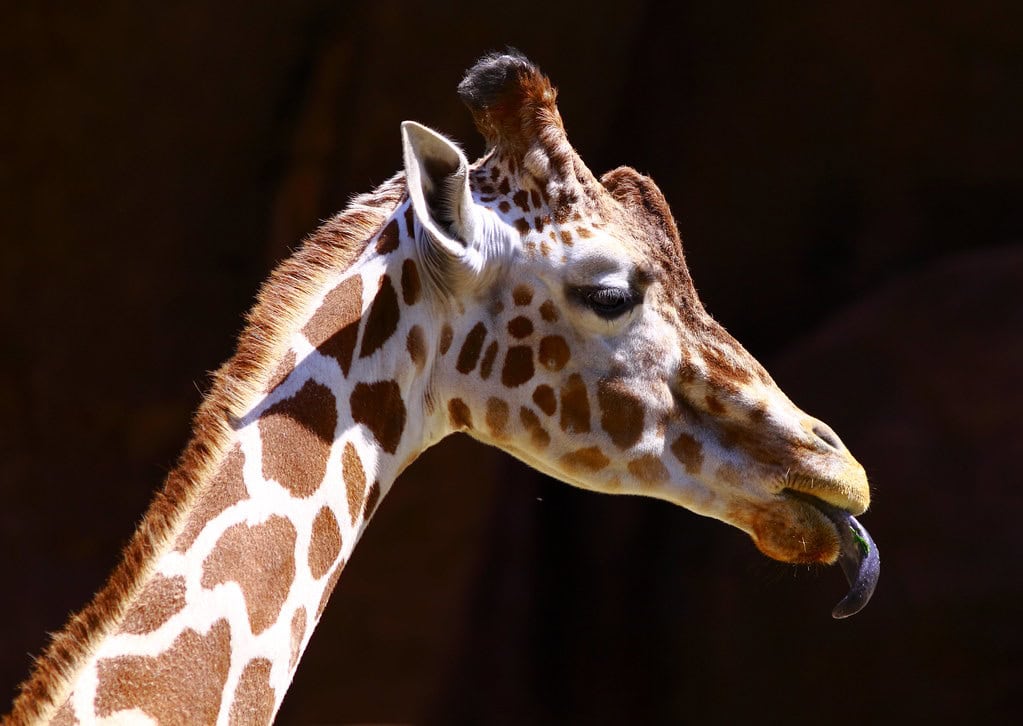
The extraordinary functionality of the giraffe’s tongue stems from its complex muscular structure, which differs significantly from that of most mammals. Unlike the human tongue, which contains intrinsic muscles arranged in a relatively simple pattern, the giraffe’s tongue features an intricate arrangement of both intrinsic and extrinsic muscles that provide exceptional control. These specialized muscle groups allow for multi-directional movement, precise extension and retraction, and the ability to grasp and manipulate objects with remarkable dexterity.
This sophisticated muscular architecture enables behaviors that would be impossible for most other mammals. Giraffes can curl the tip of their tongues with such precision that they can pluck individual leaves from between thorns, wrap their tongues multiple times around branches to strip them clean of foliage, and even use their tongues to clean their own ears and nostrils. The neural connections controlling these muscles must be equally sophisticated, allowing for the fine motor control necessary for such precise movements. This combination of unique muscular structure and neural control makes the giraffe’s tongue one of the most versatile and specialized feeding tools in the animal kingdom.
The Giraffe’s Tongue and Thermoregulation
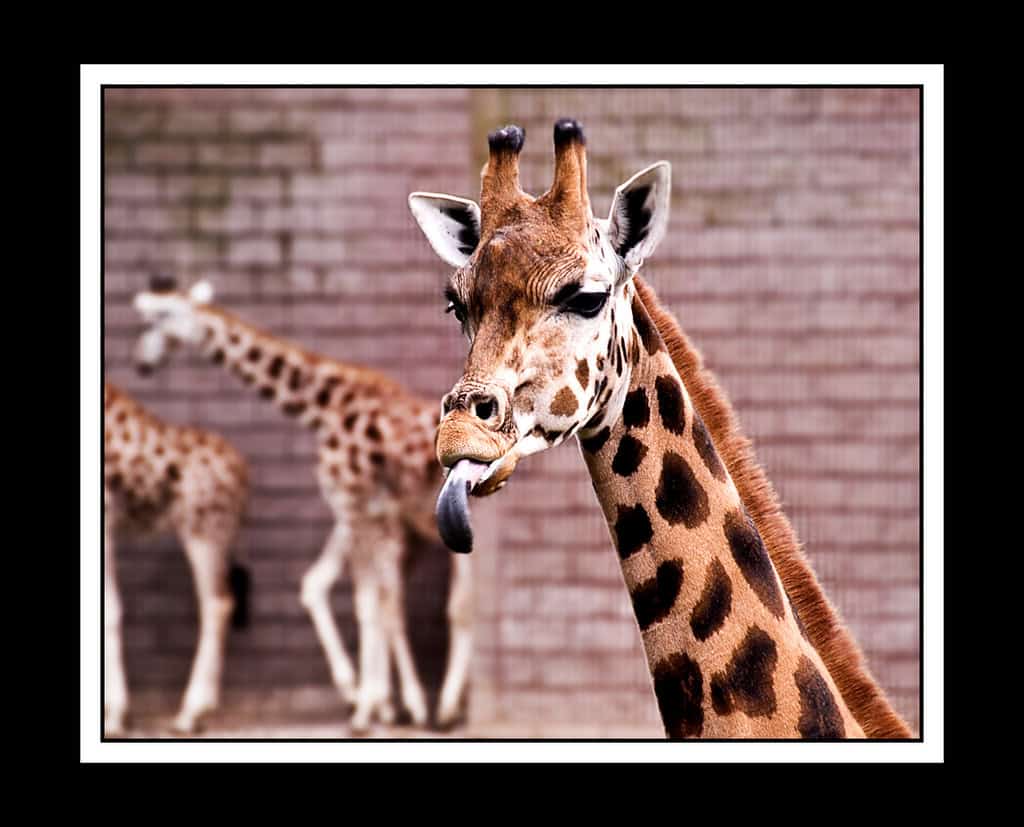
Beyond its obvious feeding functions, the giraffe’s remarkable tongue also plays a surprising role in thermoregulation – the process of maintaining optimal body temperature. The extensive vascularization (blood vessel network) within the tongue allows it to serve as a heat exchange surface. When extended outside the mouth, the tongue’s large surface area facilitates heat dissipation, helping the giraffe cool down in the scorching African heat, which regularly exceeds 100°F (38°C) during the hottest months.
Scientists have observed that giraffes sometimes extend their tongues even when not feeding, particularly during periods of intense heat. This behavior increases the surface area exposed to air, allowing for more efficient evaporative cooling as moisture on the tongue’s surface evaporates. Additionally, the tongue’s dark coloration, while primarily evolved as protection against UV radiation, also helps with heat absorption during cooler mornings, potentially helping to warm the animal during chilly African dawns. This dual-purpose adaptation demonstrates the remarkable efficiency of evolutionary processes, creating structures that serve multiple critical functions simultaneously.
Sensory Capabilities
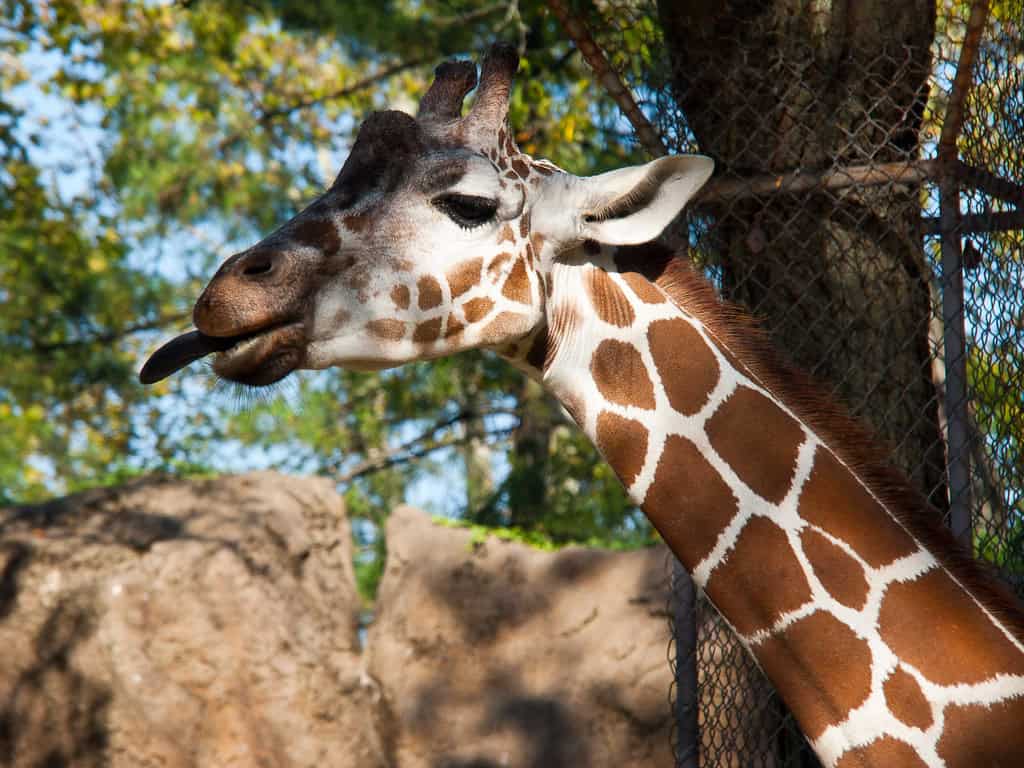
The giraffe’s tongue isn’t just a mechanical tool for gathering food; it’s also a sophisticated sensory organ packed with specialized receptors that provide crucial information about potential food sources. Like human tongues, giraffe tongues contain taste buds that allow them to distinguish between different flavor profiles, helping them identify nutritious foliage while avoiding potentially toxic plants. However, their taste preferences differ significantly from humans, as they have adapted to tolerate the bitter tannins present in acacia leaves that would taste unpleasant to most other mammals.
Beyond taste, the giraffe’s tongue contains highly sensitive tactile receptors that provide detailed feedback about texture, shape, and consistency of foliage. These receptors help giraffes assess the quality and ripeness of leaves before consumption, allowing them to select the most nutritious options available. Some research suggests their tongues may even contain specialized chemoreceptors that can detect subtle chemical compounds indicating nutritional content or toxicity levels in plants. This sensory sophistication enables giraffes to make highly selective feeding choices, maximizing their nutritional intake in environments where food quality can vary dramatically with seasons and locations.
Comparative Anatomy Among Mammals
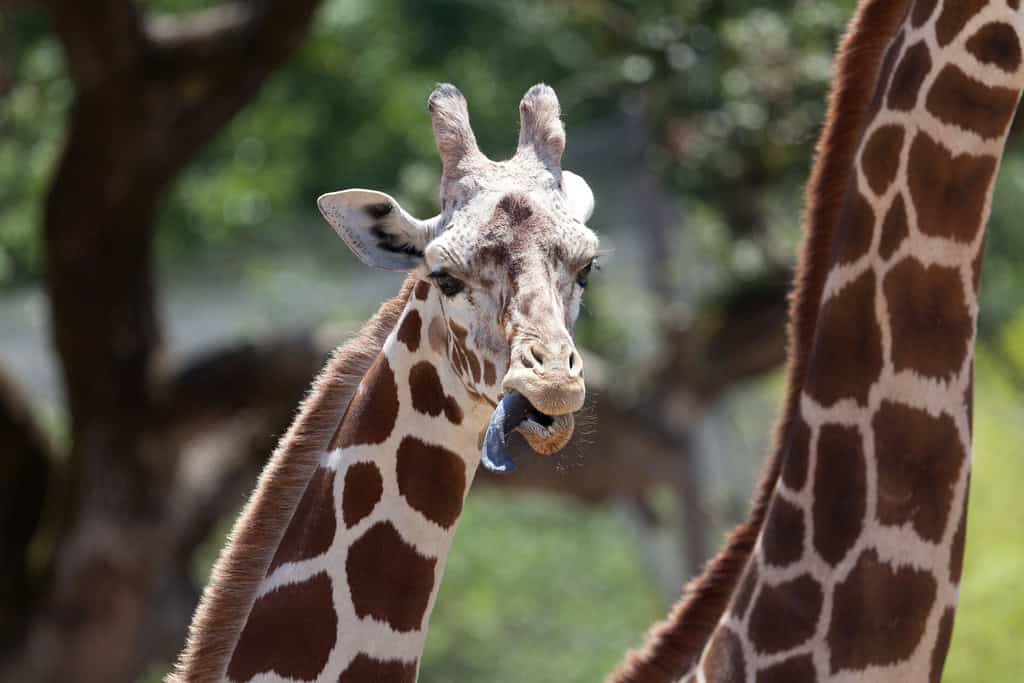
When placed in comparative context with other mammals, the giraffe’s tongue stands as a remarkable example of specialized evolution. While most mammals possess tongues primarily adapted for manipulating food within the mouth and assisting with swallowing, the giraffe has developed its tongue into a primary food-gathering tool. This adaptation is shared to some degree with other browsers like okapi (the giraffe’s closest living relative), which also possess prehensile tongues, though significantly shorter at about 12 inches (30 centimeters).
The contrast becomes even more striking when compared to other large herbivores. Elephants, for instance, rely on their trunks rather than tongues for gathering food, while zebras and wildebeest have relatively short, flat tongues designed for grazing grass close to the ground. Even among other browsers like kudu or gerenuk, which feed on similar vegetation, none have developed tongues with the remarkable length and dexterity of the giraffe. This specialized adaptation represents a prime example of evolutionary divergence, where different species develop distinct solutions to similar environmental challenges, with the giraffe’s approach being particularly successful in exploiting the high canopy feeding niche that few other mammals can access.
Tongue Development From Birth to Adulthood
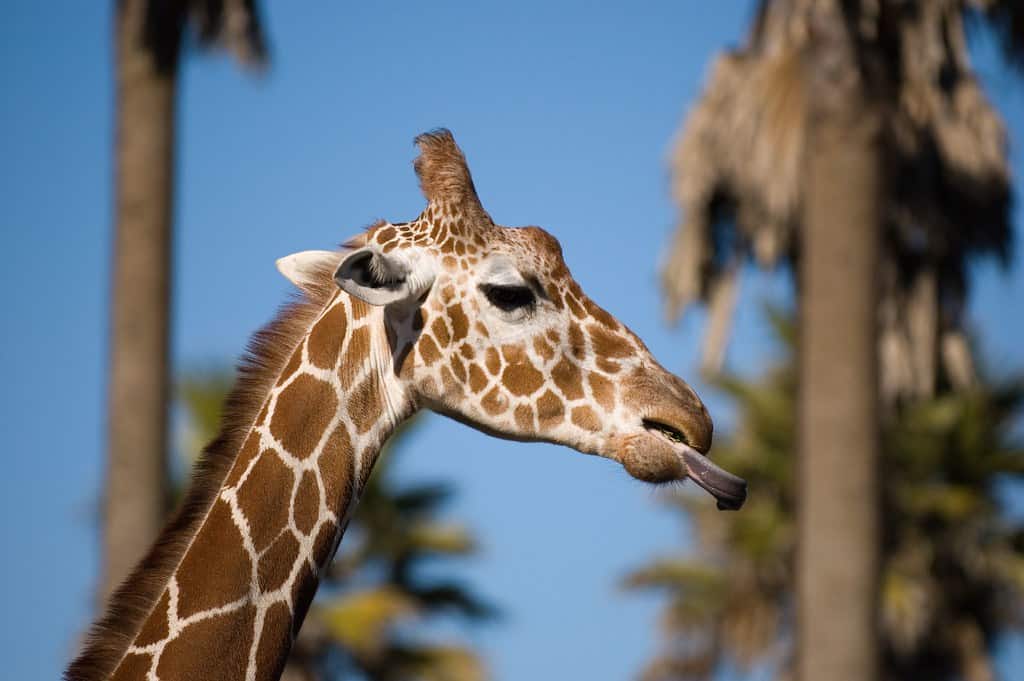
The remarkable tongue of an adult giraffe begins its development long before birth, with specialized tongue tissues forming early in embryonic development. Newborn giraffes already possess proportionally long tongues, though they lack the full dexterity and control seen in adults. This early development is crucial, as young giraffes must begin learning to feed themselves relatively quickly compared to many other mammals. Within hours of birth, calves make their first attempts at using their tongues to explore and interact with vegetation, though they rely primarily on mother’s milk for nutrition during their first months.
As young giraffes grow, their tongues undergo significant changes in both size and neuromuscular control. The tongue continues to grow proportionally with the rest of the body, gradually developing the muscular strength and precise control necessary for adult feeding behaviors. Young giraffes can be observed practicing their tongue manipulation skills, often spending hours experimenting with grasping and stripping leaves. This extended learning period is essential for developing the sophisticated tongue control that will ultimately determine their feeding efficiency as adults. By the time giraffes reach maturity at around four years of age, they have developed the full range of tongue dexterity that will serve them throughout their 25-year average lifespan in the wild.
Social and Grooming Behaviors
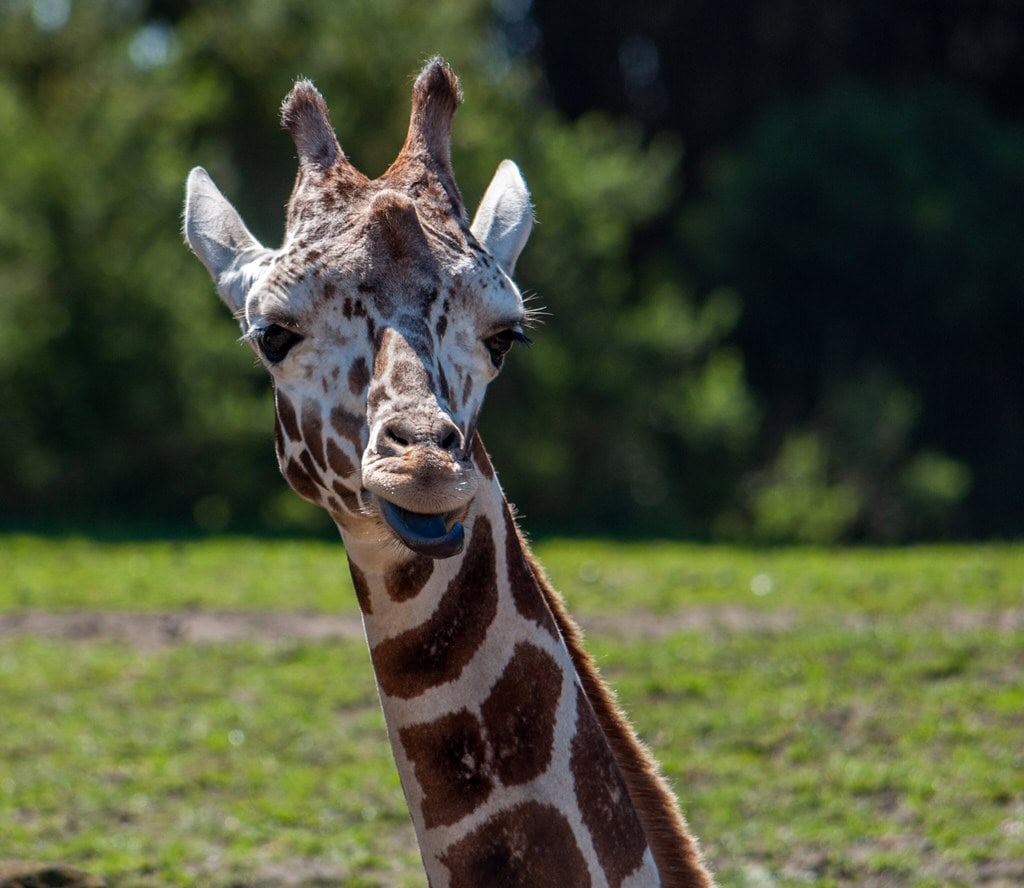
Beyond its critical feeding functions, the giraffe’s remarkable tongue plays important roles in social interactions and personal grooming. Giraffes frequently use their tongues to groom themselves, reaching areas of their bodies that would otherwise be inaccessible. With remarkable flexibility, they can clean their ears, nostrils, and even their eyes with their tongues. This self-grooming behavior helps remove parasites, clean wounds, and maintain overall hygiene, which is particularly important in environments where insects and parasites are abundant.
In social contexts, giraffes engage in mutual grooming behaviors, using their tongues to clean areas another giraffe cannot reach themselves. This behavior strengthens social bonds within giraffe herds, particularly between mothers and calves or between regularly associated adults. Researchers have also observed giraffes using tongue movements in courtship rituals, with males sometimes gently stroking females with their tongues as part of mating behaviors. These non-feeding uses of the tongue demonstrate how adaptations that evolve primarily for one purpose can be repurposed for additional functions, enriching an animal’s behavioral repertoire and enhancing its social complexity.
Evolutionary History and Development
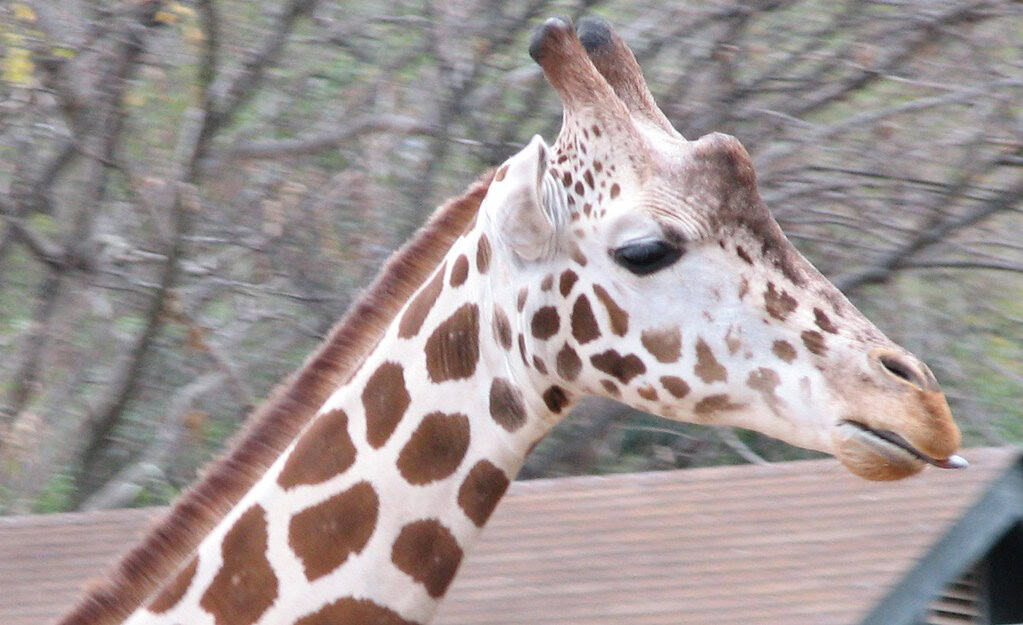
The extraordinary specialized tongue of modern giraffes represents the culmination of millions of years of evolutionary pressure. Paleontological evidence suggests that the ancestors of today’s giraffes began as shorter-necked browsers that gradually developed longer necks and tongues as they adapted to feeding on higher vegetation. This evolutionary trajectory likely intensified during periods of climate change when competition for ground-level vegetation increased, creating strong selective pressure favoring individuals that could access food sources at higher levels.
The co-evolution of the giraffe’s neck and tongue represents a fascinating example of complementary adaptations. As necks lengthened to reach higher branches, tongues simultaneously evolved greater length and dexterity to effectively manipulate food at these heights. Genetic studies indicate that several specialized genes regulate tongue development in giraffes, with mutations in these genes leading to the unique properties observed today. This evolutionary history exemplifies the principle of adaptive radiation, where organisms evolve specialized features to exploit ecological niches unavailable to their competitors. In the giraffe’s case, the remarkable tongue we observe today represents one of nature’s most successful feeding adaptations, allowing these animals to thrive in environments where food resources are literally out of reach for most other herbivores.
Conservation Implications

The giraffe’s specialized feeding apparatus, centered around its remarkable tongue, has significant implications for conservation efforts. As habitat specialists that rely on specific vegetation types – particularly acacia trees – giraffes are particularly vulnerable to environmental changes that affect their food sources. Deforestation, land conversion for agriculture, and climate change all threaten the acacia woodlands that giraffes depend upon. Without access to these specific food resources, giraffes cannot simply switch to alternative diets, as their feeding anatomy has evolved specifically for browsing tall, often thorny vegetation.
Conservation strategies must therefore focus on preserving intact acacia woodlands and the ecological processes that maintain them. This includes protecting not just the trees themselves but also the complex relationships between soil, water, and other species that maintain healthy woodland ecosystems. Additionally, conservation corridors between protected areas are crucial for allowing giraffes to move between feeding grounds as seasonal conditions change. With giraffe populations having declined by approximately 40% over the past three decades, understanding and protecting their specialized feeding ecology becomes increasingly urgent. The remarkable seven-foot tongue that enables their survival also makes them vulnerable to environmental changes that disrupt their specialized feeding niche.
Conclusion: A Marvel of Natural Engineering

The giraffe’s extraordinary tongue stands as one of nature’s most remarkable examples of specialized adaptation, demonstrating the incredible precision with which evolutionary processes can shape anatomy to match ecological challenges. Far more than just an interesting curiosity, this specialized organ represents the culmination of millions of years of natural selection, resulting in a feeding apparatus perfectly suited to the giraffe’s unique ecological niche. The combination of exceptional length, unusual coloration, remarkable dexterity, and sensory sophistication makes the giraffe’s tongue a masterpiece of biological engineering that continues to fascinate scientists and nature enthusiasts alike.
As we contemplate this remarkable adaptation, we gain deeper appreciation for the intricate relationships between form and function in the natural world. The giraffe’s tongue reminds us that even seemingly simple body parts can evolve extraordinary specialization, often serving multiple functions simultaneously in ways that enhance an organism’s survival. In an age where biodiversity faces unprecedented threats, understanding such specialized adaptations underscores the importance of conservation efforts that protect not just species themselves, but the complex ecological relationships they depend upon. The giraffe’s remarkable tongue, with its astonishing capabilities, stands as a powerful symbol of nature’s ingenuity and the irreplaceable value of each uniquely adapted species.
- Bees Can Do Basic Math - August 20, 2025
- How Climate Change Is Bringing More Deadly Animals to the US - August 20, 2025
- The Only Mammal That Can Breathe Through Its Skin - August 19, 2025

